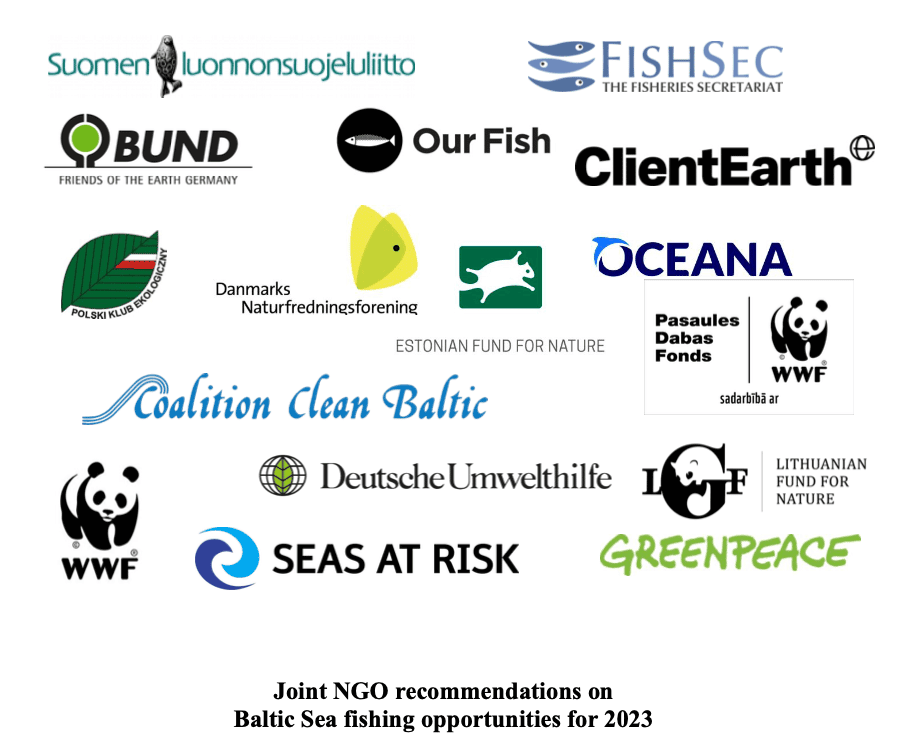Download PDF: Joint NGO recommendations on Baltic Sea fishing opportunities for 2023
In October 2022, EU fisheries ministers will agree on fishing opportunities in the Baltic Sea for 2023. As the deadline to end overfishing by 2020 at the latest as legally prescribed by Article 2(2) of the Common Fisheries Policy (CFP) has passed, all fishing limits must be in line with sustainable exploitation rates.
Last year, the EU AGRIFISH Council set four out of ten Total Allowable Catches (TACs) in the Baltic Sea exceeding the best available scientific advice for 2022, thereby contravening the CFP deadline. The European Commission proposals exceeded scientific advice for the four TACs – eastern Baltic cod, western Baltic herring, salmon in the main Baltic basin and the Gulf of Finland salmon. Fisheries ministers further increased some catch limits above what was proposed by the European Commission3
However, behind all of the numbers, the real problem is that scientific advice and the models underpinning it are not delivering ecosystem-based management options. Setting TAC based on single species advice omits the need to consider sub-populations at risk and misses consideration of size and age distribution. ICES can produce more comprehensive advice but the decision-makers must request this and until they do, they must set TACs with much greater caution.
The results of the holistic assessment by the Baltic Marine Environment Protection Commission (Helsinki Commission, HELCOM) on the state of the Baltic Sea reflect that several action areas lag behind in implementation, despite the deadline for achieving Good Environmental Status (GES) of the marine environment by 2020 according to the Marine Strategy Framework Directive (MSFD) and by 2021 according to the Baltic Sea Action Plan (BSAP). The European Green Deal commits the EU to tackle the impacts of climate change and protecting and restoring biodiversity. Specifically, the EU Biodiversity Strategy commits to ecosystem-based management, a transition to more selective and less damaging fishing methods, and to set all fishing limits at or below Maximum Sustainable Yield (MSY) levels, to restore ocean health. The Action Plan to conserve fisheries resources and protect marine ecosystems noted as a deliverable in the Biodiversity Strategy must become a crucial strategy to improve implementation of, and fill obvious gaps in, EU policies to put European fisheries management on a path where the full ecosystem and climate impacts of fishing are properly measured and mitigated.
The Commission and Ministers must reconsider the current approach by requesting new and different scientific advice that, for example, adequately reflects ecosystem considerations, safeguards vulnerable sub-populations and prioritises a healthy size and age distribution, or we will face more stocks faltering. The solution here and now is to take a more precautionary approach by staying in the lower bounds of the TAC advice ranges.
The October AGRIFISH Council provides the Commission and fisheries ministers with a clear and attainable opportunity to deliver on their commitments in the updated HELCOM Baltic Sea Action Plan and the Our Baltic Declaration from 2020 initiated by Commissioner Virginijus Sinkevičius, as well as on their legal obligation according to the CFP to end overfishing. It is also an opportunity to begin to realise the ambition of the Biodiversity Strategy.
The European Ombudsman has confirmed that fishing opportunities documents contain ‘environmental information’ within the meaning of the Aarhus Convention, and made recommendations to improve the transparency of the Council when setting fishing opportunities. The Ombudsman further confirmed a finding of maladministration in April 2020, expressing disappointment that Council decision-making contravened key democratic and transparency standards. We therefore urge the Commission and decision-makers to make the decision-making process of setting fishing opportunities fully transparent.
The following text outlines the joint NGO recommendations on Baltic Sea fishing opportunities for 2023 in the context of environmental regulations, EU fisheries legislation, scientific advice on catch limits, and the sharing of stocks with third countries.
Download PDF: Joint NGO recommendations on Baltic Sea fishing opportunities for 2023

